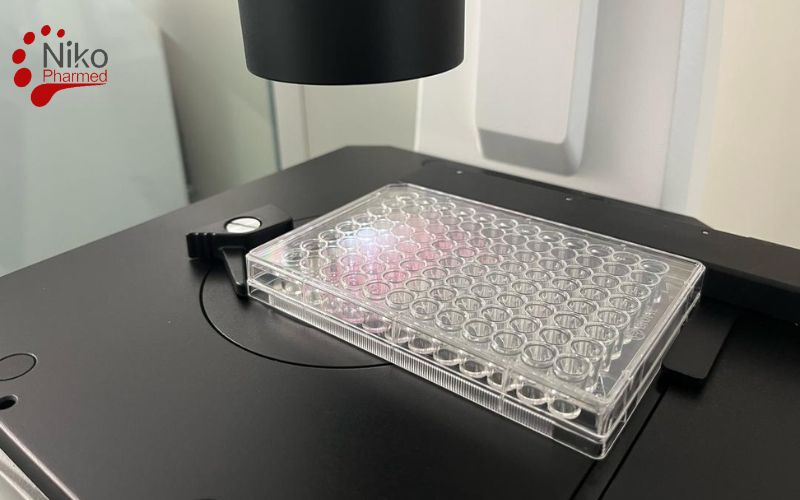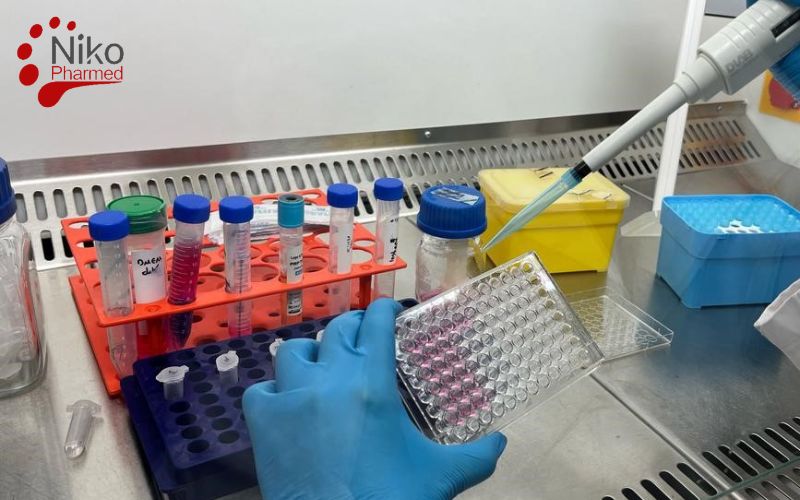What is Cytotoxity Testing?
The cytotoxicity test, as defined by ISO 10993-5, is a critical in vitro biological evaluation used to determine whether medical devices or their extracts cause toxic effects on cultured mammalian cells. This test assesses the potential of a material to damage or kill cells through direct contact, indirect exposure via diffusion, or through extracts. It is an essential part of the biocompatibility assessment for medical devices, helping manufacturers identify harmful cellular reactions before clinical use. A material is considered cytotoxic if it reduces cell viability or alters cell morphology significantly, indicating potential biological risks.

Cytotoxicity Testing ISO 10993-5
In ISO 10993-5, the cytotoxicity test is defined as an in vitro biological evaluation method used to determine the potential of medical device materials, extracts, or leachables to cause cellular damage or death when in contact with cultured mammalian cells. The standard outlines that cytotoxicity is assessed by observing changes in cell viability, morphology, and proliferation after exposure to the test substance, using methods such as direct contact, extract exposure, or agar diffusion. A material is considered cytotoxic if it causes a reduction in cell viability greater than 30% compared to a negative control, indicating it may pose a risk to human health upon clinical use.
To request testing or a complimentary consultation contact Nikopharmad
Cytotoxicity Testing Methods
According to ISO 10993-5, cytotoxicity testing methods are designed to evaluate the potential of medical device materials to cause toxic effects on cultured mammalian cells. The standard outlines three primary methods:
direct contact, indirect contact using agar diffusion, and extract dilution tests.
- Direct Contact Method places the test material directly onto a confluent layer of cells, typically L929 mouse fibroblasts, and observes cellular changes such as rounding, detachment, or lysis after 24–72 hours.
- Agar Diffusion Method involves placing the material on an agar layer covering the cell monolayer, allowing diffusion of leachables. This protects cells from physical trauma while still detecting cytotoxic leachates.
- Extract Test Method requires the material to be incubated in a cell culture medium (or relevant extractant) to release potential toxic substances. The extract is then applied to the cells and their viability is assessed using metabolic indicators (like MTT or XTT assays), membrane integrity (e.g., trypan blue exclusion), or morphological observation.
Human indicators in this context refer to cellular responses observable under the microscope, such as cell death, morphological alterations (shrinkage, granularity, detachment), and loss of membrane integrity—reflecting how the human body’s cells might react to the same material.
Cytotoxity Testing Lab
At International & Accredited Lab Nikopharmad Laboratory Network, we are committed to providing accurate, reliable, and high-quality biocompatibility testing services for medical devices and pharmaceutical products. Holding the esteemed ISO 17025 certification and ILAC accreditation, we adhere to internationally recognized standards, ensuring that our testing processes meet the highest quality and regulatory requirements.
Why Choose Nikopharmad Laboratory?
ILAC accreditation
Nikopharmad Laboratory is proudly certified with ISO 17025 and holds ILAC accreditation. These prestigious certifications ensure that our laboratory operates with the highest standards of quality and competence, providing reliable and internationally recognized testing services for medical devices and pharmaceutical products. Our commitment to maintaining these certifications demonstrates our dedication to excellence and compliance with global regulatory requirements.
Comprehensive Testing Capabilities
We offer a broad range of biocompatibility tests, each designed to assess the safety and performance of your products in compliance with international regulatory frameworks.
Expertise and Experience
With extensive experience in the medical and pharmaceutical sectors, our laboratory is equipped with cutting-edge technology and a team of highly trained professionals who ensure accurate, timely, and thorough testing results.
Efficient and Timely Results
We understand the importance of time in product development. Our laboratory strives to deliver fast and reliable results, ensuring your products are tested and ready for market entry as efficiently as possible.
Confidentiality and Integrity
At Nikopharmad, we prioritize the confidentiality of your sensitive data and intellectual property. Our strict adherence to confidentiality agreements guarantees that your information remains protected throughout the testing process.
Global Compliance and Support
Whether you are preparing to enter the FDA, or other global markets, our laboratory ensures that your products comply with all necessary regulatory standards, facilitating a smooth path to market approval.
Choose Nikopharmad for Your Cytotoxity Testing Needs
By choosing International Nikopharmad Laboratory, you are selecting a trusted partner that not only meets but exceeds international testing standards. Our ISO 17025 certification, expert team, and commitment to excellence make us the ideal choice for ensuring the safety, compliance, and success of your medical devices and pharmaceutical products.
How is Cytotoxicity Testing procedure?
The cytotoxicity test procedure, according to ISO 10993-5, follows a structured, step-by-step approach to evaluate the toxic potential of medical devices on cultured mammalian cells. Here’s how it is conducted:
Preparation of Test Samples
The medical device or its material is cleaned and sterilized. Depending on the method used, either solid samples or extracts are prepared. For extract tests, the material is incubated in a suitable extraction medium (e.g., culture media with or without serum) under controlled conditions (usually 37°C for 24 hours).
Cell Culture Maintenance
A sensitive, standardized cell line such as L929 mouse fibroblasts is cultured in optimal conditions (humidified incubator at 37°C with 5% CO₂) until a confluent monolayer is formed.
Exposure Methods
-
- Direct Contact: The sample is placed directly on the cell monolayer.
- Agar Diffusion: The sample is placed on an agar layer overlying the cell culture.
- Extract Exposure: Prepared extracts are added to the cell culture in various concentrations.
Incubation Period
The cells are incubated for 24 to 72 hours, depending on the test design, allowing any leachable toxic substances to interact with the cells.
Assessment of Cytotoxicity
-
- Visual Microscopic Evaluation: Human indicators such as cell morphology changes (e.g., rounding, detachment, granulation), lysis, and confluence loss are observed.
- Quantitative Viability Assays: Tests like MTT, XTT, NRU, or LDH release are used to measure metabolic activity or membrane integrity.
- Threshold Determination: A reduction of more than 30% in cell viability compared to controls indicates cytotoxic potential.
Interpretation and Classification
Based on the degree of cell damage or viability reduction, the material is graded from non-cytotoxic to severely cytotoxic.
This stepwise protocol ensures reliable detection of cytotoxic effects, mirroring how human tissues might react, and is crucial for determining the safety of medical devices before clinical application.
conclusion
In conclusion, the cytotoxicity test, as outlined by ISO 10993-10, plays a crucial role in assessing the biocompatibility of medical devices and materials. By evaluating the potential toxic effects of a material on cultured cells, this test helps to ensure that the device or material does not cause harmful reactions in vivo. Adherence to the ISO 10993-10 standard provides a reliable framework for testing, which aids manufacturers in meeting regulatory requirements and safeguarding patient health. Ultimately, the cytotoxicity test serves as a foundational element in the broader context of biological evaluation, contributing to the development of safe and effective medical products.
Reference:iso.org


